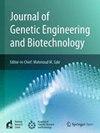Targeting Streptococcus pyogenes atpF protein for multi-epitope vaccine development: a genomics-driven immunoinformatics strategy
IF 2.8
Q3 Biochemistry, Genetics and Molecular Biology
Journal of Genetic Engineering and Biotechnology
Pub Date : 2025-08-05
DOI:10.1016/j.jgeb.2025.100546
引用次数: 0
Abstract
Streptococcus pyogenes, a medium-priority pathogen on the WHO’s 2024 Bacterial Pathogen Priority List, is a major cause of infectious disease-related mortality. The increasing prevalence of antibiotic resistance, coupled with the absence of a licensed vaccine due to the pathogen’s genetic diversity and autoimmune concerns, underscores the need for novel therapeutic strategies. This study employs reverse vaccinology and subtractive proteomics to design a multi-epitope vaccine targeting atpF, a conserved extracellular protein essential for ATP synthesis. The atpF protein was identified based on its high antigenicity and functional importance in S. pyogenes. Three vaccine constructs (SM1, SM2, and SM3) were designed by integrating antigenic B-cell and T-cell epitopes with immune-modulating adjuvants and linkers. Physicochemical and immunological assessments confirmed their stability, solubility, and antigenicity. Molecular modeling identified SM1 as the most promising candidate, demonstrating superior immune receptor binding affinity and flexible epitope interactions, facilitating effective antibody recognition. In silico immune simulations further demonstrated SM1′s potential to elicit strong humoral and cellular immune responses, while codon optimization confirmed efficient expression in E. coli. These findings introduce atpF as a promising vaccine target and highlight SM1′s potential as a viable vaccine candidate. However, experimental validation is essential to confirm its efficacy, safety, and immunogenicity in vivo. This study underscores the role of computational modeling in accelerating vaccine development, providing a strategic alternative to traditional approaches.

针对化脓性链球菌atpF蛋白的多表位疫苗开发:基因组学驱动的免疫信息学策略
化脓性链球菌是世卫组织2024年细菌病原体重点清单上的一种中等重点病原体,是导致传染病相关死亡的主要原因。抗生素耐药性的日益普遍,加上由于病原体的遗传多样性和自身免疫问题而缺乏许可的疫苗,强调需要新的治疗策略。本研究采用反向疫苗学和减法蛋白质组学设计了一种针对ATP的多表位疫苗,ATP是ATP合成所必需的一种保守的细胞外蛋白。atpF蛋白在化脓性葡萄球菌中具有很高的抗原性和重要的功能。通过将抗原b细胞和t细胞表位与免疫调节佐剂和连接剂结合,设计了三种疫苗结构(SM1、SM2和SM3)。理化和免疫学评价证实了它们的稳定性、溶解度和抗原性。分子模型鉴定SM1是最有希望的候选者,显示出优越的免疫受体结合亲和力和灵活的表位相互作用,促进有效的抗体识别。硅免疫模拟进一步证明SM1有可能引发强烈的体液和细胞免疫反应,而密码子优化证实了SM1在大肠杆菌中的高效表达。这些发现介绍了atpF作为一种有希望的疫苗靶点,并强调了SM1作为一种可行的候选疫苗的潜力。然而,实验验证是必要的,以确认其有效性,安全性和体内免疫原性。这项研究强调了计算建模在加速疫苗开发中的作用,为传统方法提供了一种战略替代方案。
本文章由计算机程序翻译,如有差异,请以英文原文为准。
求助全文
约1分钟内获得全文
求助全文
来源期刊

Journal of Genetic Engineering and Biotechnology
Biochemistry, Genetics and Molecular Biology-Biotechnology
CiteScore
5.70
自引率
5.70%
发文量
159
审稿时长
16 weeks
期刊介绍:
Journal of genetic engineering and biotechnology is devoted to rapid publication of full-length research papers that leads to significant contribution in advancing knowledge in genetic engineering and biotechnology and provide novel perspectives in this research area. JGEB includes all major themes related to genetic engineering and recombinant DNA. The area of interest of JGEB includes but not restricted to: •Plant genetics •Animal genetics •Bacterial enzymes •Agricultural Biotechnology, •Biochemistry, •Biophysics, •Bioinformatics, •Environmental Biotechnology, •Industrial Biotechnology, •Microbial biotechnology, •Medical Biotechnology, •Bioenergy, Biosafety, •Biosecurity, •Bioethics, •GMOS, •Genomic, •Proteomic JGEB accepts
 求助内容:
求助内容: 应助结果提醒方式:
应助结果提醒方式:


